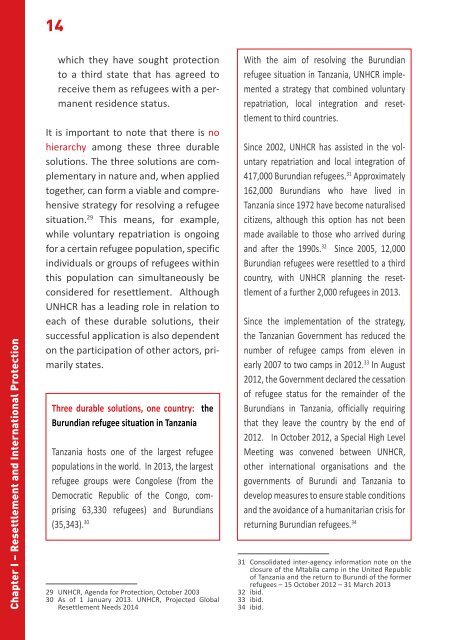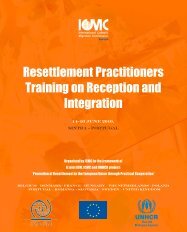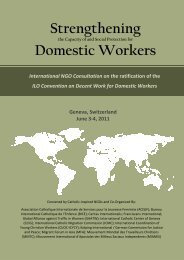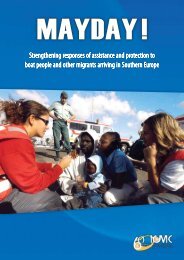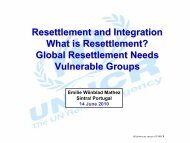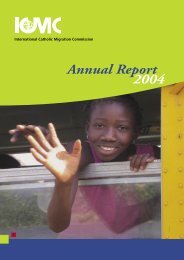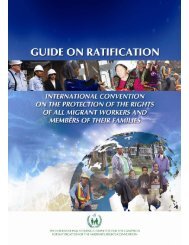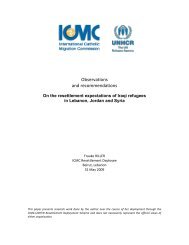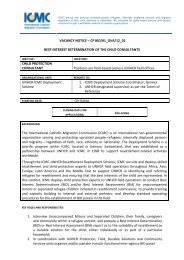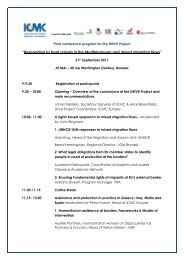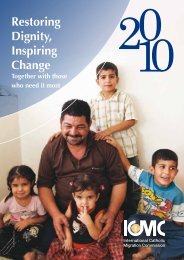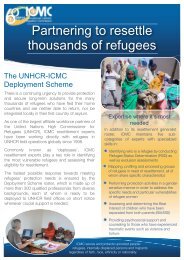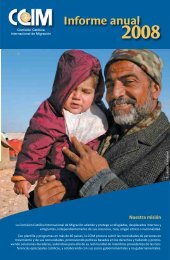ICMCEUROPE WelcometoEurope.pdf (5.89 MB)
ICMCEUROPE WelcometoEurope.pdf (5.89 MB)
ICMCEUROPE WelcometoEurope.pdf (5.89 MB)
You also want an ePaper? Increase the reach of your titles
YUMPU automatically turns print PDFs into web optimized ePapers that Google loves.
14<br />
Chapter I – Resettlement and International Protection<br />
which they have sought protection<br />
to a third state that has agreed to<br />
receive them as refugees with a permanent<br />
residence status.<br />
It is important to note that there is no<br />
hierarchy among these three durable<br />
solutions. The three solutions are complementary<br />
in nature and, when applied<br />
together, can form a viable and comprehensive<br />
strategy for resolving a refugee<br />
situation. 29 This means, for example,<br />
while voluntary repatriation is ongoing<br />
for a certain refugee population, specific<br />
individuals or groups of refugees within<br />
this population can simultaneously be<br />
considered for resettlement. Although<br />
UNHCR has a leading role in relation to<br />
each of these durable solutions, their<br />
successful application is also dependent<br />
on the participation of other actors, primarily<br />
states.<br />
Three durable solutions, one country: the<br />
Burundian refugee situation in Tanzania<br />
Tanzania hosts one of the largest refugee<br />
populations in the world. In 2013, the largest<br />
refugee groups were Congolese (from the<br />
Democratic Republic of the Congo, comprising<br />
63,330 refugees) and Burundians<br />
(35,343). 30<br />
29 UNHCR, Agenda for Protection, October 2003<br />
30 As of 1 January 2013. UNHCR, Projected Global<br />
Resettlement Needs 2014<br />
With the aim of resolving the Burundian<br />
refugee situation in Tanzania, UNHCR implemented<br />
a strategy that combined voluntary<br />
repatriation, local integration and resettlement<br />
to third countries.<br />
Since 2002, UNHCR has assisted in the voluntary<br />
repatriation and local integration of<br />
417,000 Burundian refugees. 31 Approximately<br />
162,000 Burundians who have lived in<br />
Tanzania since 1972 have become naturalised<br />
citizens, although this option has not been<br />
made available to those who arrived during<br />
and after the 1990s. 32 Since 2005, 12,000<br />
Burundian refugees were resettled to a third<br />
country, with UNHCR planning the resettlement<br />
of a further 2,000 refugees in 2013.<br />
Since the implementation of the strategy,<br />
the Tanzanian Government has reduced the<br />
number of refugee camps from eleven in<br />
early 2007 to two camps in 2012. 33 In August<br />
2012, the Government declared the cessation<br />
of refugee status for the remainder of the<br />
Burundians in Tanzania, officially requiring<br />
that they leave the country by the end of<br />
2012. In October 2012, a Special High Level<br />
Meeting was convened between UNHCR,<br />
other international organisations and the<br />
governments of Burundi and Tanzania to<br />
develop measures to ensure stable conditions<br />
and the avoidance of a humanitarian crisis for<br />
returning Burundian refugees. 34<br />
31 Consolidated inter-agency information note on the<br />
closure of the Mtabila camp in the United Republic<br />
of Tanzania and the return to Burundi of the former<br />
refugees – 15 October 2012 – 31 March 2013<br />
32 ibid.<br />
33 ibid.<br />
34 ibid.


